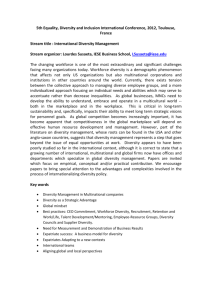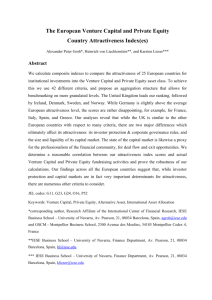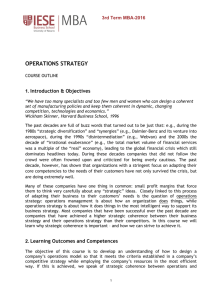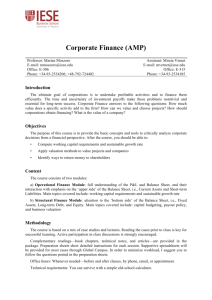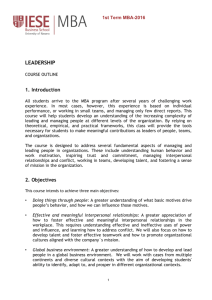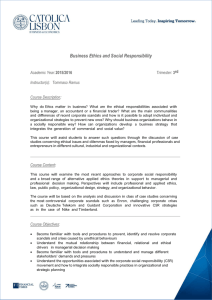XX Year MBA XX - IESE Business School
advertisement
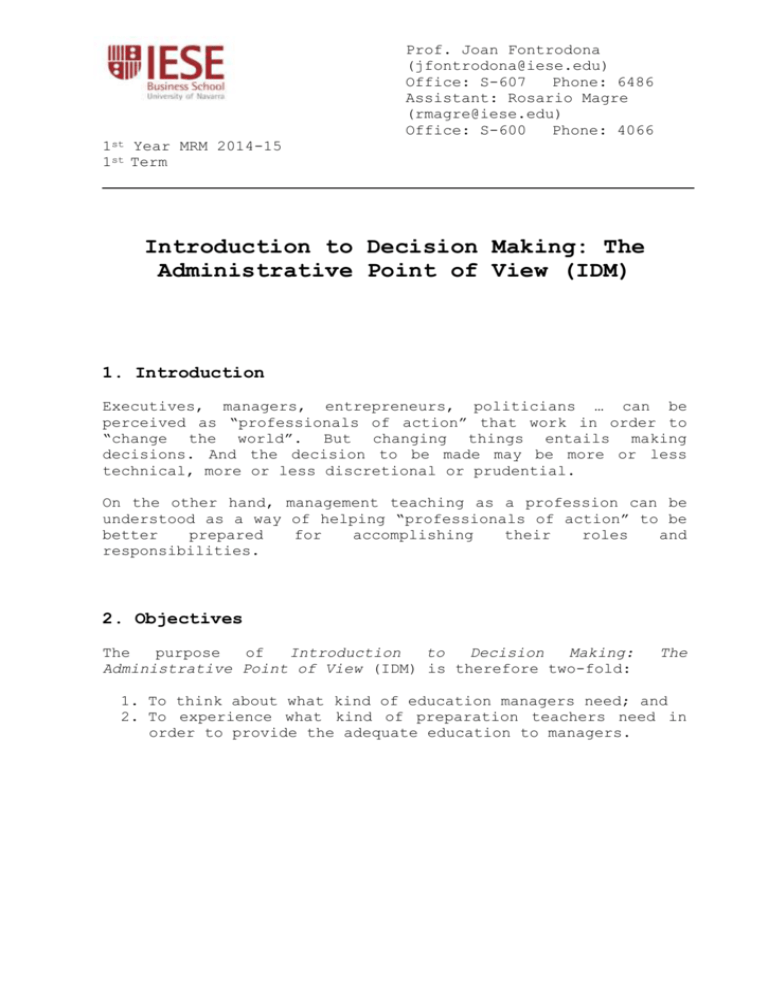
Prof. Joan Fontrodona (jfontrodona@iese.edu) Office: S-607 Phone: 6486 Assistant: Rosario Magre (rmagre@iese.edu) Office: S-600 Phone: 4066 1st Year MRM 2014-15 1st Term Introduction to Decision Making: The Administrative Point of View (IDM) 1. Introduction Executives, managers, entrepreneurs, politicians … can be perceived as “professionals of action” that work in order to “change the world”. But changing things entails making decisions. And the decision to be made may be more or less technical, more or less discretional or prudential. On the other hand, management teaching as a profession can be understood as a way of helping “professionals of action” to be better prepared for accomplishing their roles and responsibilities. 2. Objectives The purpose of Introduction to Decision Making: Administrative Point of View (IDM) is therefore two-fold: The 1. To think about what kind of education managers need; and 2. To experience what kind of preparation teachers need in order to provide the adequate education to managers. Prof. Joan Fontrodona (jfontrodona@iese.edu) Office: S-607 Phone: 6486 Assistant: Rosario Magre (rmagre@iese.edu) Office: S-600 Phone: 4066 1st Year MRM 2014-15 1st Term 3. Learning Outcomes The course is intended to provide the students with: - A broader perspective of decision making, and a critical attitude towards the use of technical tools An awareness of the singular richness of prudential decision making as a professional skill for managers A familiarity with the case method and its particularities as a method for training on prudential decision making Prof. Joan Fontrodona (jfontrodona@iese.edu) Office: S-607 Phone: 6486 Assistant: Rosario Magre (rmagre@iese.edu) Office: S-600 Phone: 4066 1st Year MRM 2014-15 1st Term 4. Competencies The course is designed to provide the students with a set of knowledge, skills and attitudes that help them in their professional endeavors as facilitators of teaching and learning processes. Specifically, the course develops these competencies: - - - - - - - - Identify and solve business problems, often with uncertain and incomplete information, and involving direction and management of people in organizational frameworks (CG2) Conduct a critical analysis, evaluation and synthesis of new and complex ideas with the objective to produce general principles applicable to business situations (CG3) Profound understanding and appreciation of the importance of the human factor within an organizational framework (CG4) Use appropriate tools and techniques for problem solving, correction contrasting and decision validation (CG6) Students should be able to communicate clearly and concisely their conclusions, underlying knowledge and reasons to a specialized and non-specialized audience (CB9) Distinguishing of the different fields of management sciences and acknowledgement of the research methodologies related to them (CE4) Ability to take current management and organizational problems and identify how different theories of organizations can help us understand them (CE6) Use the acquired knowledge and skills and apply them to a constantly changing business environment as generated by current societies (CE10) Publicly present ideas, procedures or research reports to advise people and organizations (CE19) Capability to assess the general economic situation of a company in order to analyze the implications this has for its management (CE22) Prof. Joan Fontrodona (jfontrodona@iese.edu) Office: S-607 Phone: 6486 Assistant: Rosario Magre (rmagre@iese.edu) Office: S-600 Phone: 4066 1st Year MRM 2014-15 1st Term 5. Content The purpose of the course is to think about the decision making process within the business context. The course focuses on two main themes that are related: - - How do business people make decisions, and what are the main characteristics of this decision making process compared to other frameworks (theoretical knowledge, scientific knowledge, …). How can this decision making process be taught, and what are the implications for teaching and research. The course will consist of 20 sessions, divided into modules of two consecutive sessions each with a break in between. In each module a case and some readings will be discussed. The approach will be two-pronged: The first session of each module will be a standard case method session, followed by some conclusions on the purely pedagogical, “back-office” questions related to the case. The second session will look at different issues related both to management education and teaching as a profession. 6. Methodology The “case method” is the teaching method that best suits the needs for learning about prudential decision making. Therefore, the course will focused mainly on “the case method”, since the best way for understanding the value and characteristics of this learning method is to experience it in first person. The course will combine theoretical sessions (discussion of readings) and cases. The theoretical sessions will provide the students with the theoretical background of the course; the discussion of cases will allow the students to experience in first-hand an appropriate methodology for the issues raised by the course Prof. Joan Fontrodona (jfontrodona@iese.edu) Office: S-607 Phone: 6486 Assistant: Rosario Magre (rmagre@iese.edu) Office: S-600 Phone: 4066 1st Year MRM 2014-15 1st Term 7. Evaluation The students will be graded based on the quality of their participation in class (70%). Also they will be asked to write two reports with an analysis of a case (to be assigned in class) (30%) Prof. Joan Fontrodona (jfontrodona@iese.edu) Office: S-607 Phone: 6486 Assistant: Rosario Magre (rmagre@iese.edu) Office: S-600 Phone: 4066 1st Year MRM 2014-15 1st Term 8. Course Outline and Bibliography SESION DESCRIPTION CASE/ACTIVITY INTRODUCTION 01/Oc t 1 Why are you here? - Because Wisdom can’t be told (HBS 9-451-005) The case method - ASNN-1-E The Case Method and the development of capacities for action 2 PART I. What do managers need to be taught? 08/Oc t 3 Building (1) 4 Analysis 15/Oc t 5 Building (2) 6 the framework ASN-47-E Eólica de Composites. S.A. -ASNN-7 Think for yourself - The high cost of accurate knowledge, (HBR) - Mintzberg, Analysis framing and frame breaking. the framework - ASN-48-E Tennis Gavà - ASNN-8 You are not a Technician Beyond analysis Combining models with intuition to improve decisions. Wharton - Fontrodona, Creativity: The logical principle of action Prof. Joan Fontrodona (jfontrodona@iese.edu) Office: S-607 Phone: 6486 Assistant: Rosario Magre (rmagre@iese.edu) Office: S-600 Phone: 4066 1st Year MRM 2014-15 1st Term SESION DESCRIPTION 22/Oc t 7 Building the framework (3) 8 Open questions in teaching CASE/ACTIVITY - ASN-12-E The Club - Bennis and O’Toole, How Business Schools lost their way. - Burke and Rau, The Research Teaching Gap in Management. PART II. What do we need for teaching to managers? 31/Oc t 9 10 05/No v 11 12 Integrating areas knowledge (1) Skills Integrating areas knowledge (2) The audience of - ASN-41-E Mas del Prat (Rev. 1/2011) - ASNN-2-E Pillars of a pedagogical process for educating professionals of actions - Gosling and Mintzberg, The five minds of a manager. (HBR) of - DG-948-E - TDN-85-E purpose? The Tower Power...for what - Bergman et al., Narcissism in Management Education. Prof. Joan Fontrodona (jfontrodona@iese.edu) Office: S-607 Phone: 6486 Assistant: Rosario Magre (rmagre@iese.edu) Office: S-600 Phone: 4066 1st Year MRM 2014-15 1st Term SESION 12/No v 13 14 DESCRIPTION CASE/ACTIVITY Integrating levels analysis (1) - Preparing for class, HBS 9682-014 - ASNN-6-E The Case Method: The Instructor as a Choreographer The class 21/No v 15 Integrating levels analysis (2) 16 The teaching career 26/No v 17 Integrating levels analysis (3) 18 03/Di c 19-20 Open questions in research Revisiting the of management of - ASN-33-E Escatsa of - HBS 9-190-053 Automation Consulting Services - Bedeian et al., Doctoral degree prestige and the academic marketplace: A study of career mobility within the management discipline. of - 909B06 Adamac Ghoshal, Bad management theories are destroying good practices. - Peng and Dess, In the Sprit of Scholarship. notion Andreu, R. and Rosanas, J.M., Manifesto for a better management. A rational and humanistic view Prof. Joan Fontrodona (jfontrodona@iese.edu) Office: S-607 Phone: 6486 Assistant: Rosario Magre (rmagre@iese.edu) Office: S-600 Phone: 4066 1st Year MRM 2014-15 1st Term 9. Professor’s Biography Prof. Joan Fontrodona Professor of Business Ethics Joan Fontrodona is Professor and Head of the Business Ethics Department at IESE Business School, and Director of the IESE Center for Business in Society. He holds a Ph.D. in Philosophy and an MBA. He is the Chairman of EBEN-Spain, the Spanish branch of the European Business Ethics Network. He serves on the Board of Foretica and the CSR Commission of the Catalonian Association of Auditors. He is associate researcher at the Enterprise and Humanism Institute of the University of Navarra. He is the IESE representative at the Academy of Business in Society (ABIS), and the Global Compact and the PRME Initiative. His main areas of research and teaching are business ethics, corporate social responsibility, ethical and anthropological foundations for management, and social and political trends in management. He is the author and co-author of several books and articles on these topics, as well as member of editorial boards and reviewer of several specialized journals in the field of business ethics and corporate social responsibility.
